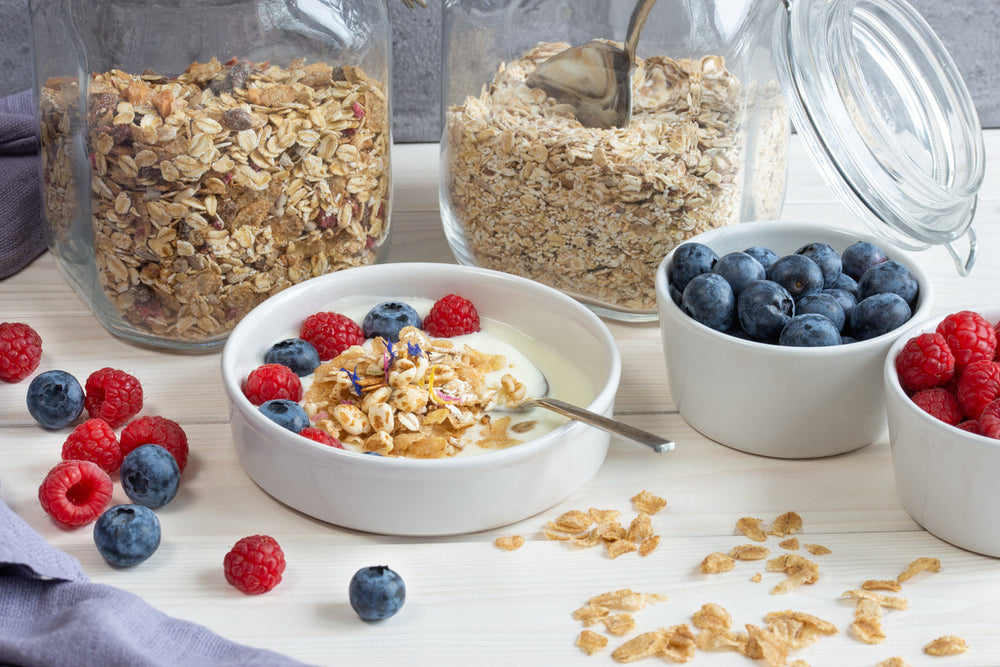Muesli is a wholesome and nutritious breakfast choice enjoyed worldwide, but there are notable differences in how it is made, consumed, and marketed in Britain and the United States. While both countries’ muesli share the core ingredients of oats, dried fruits, nuts, and seeds, the variations in texture, sugar content, and preparation methods set them apart.
In this article, we will explore the key differences between British and American muesli, considering their ingredients, nutritional value, and cultural significance.
Origins and evolution
British muesli
Muesli originated in Switzerland in the early 1900s, created by Swiss doctor Maximilian Bircher-Brenner as a health-focused meal for his patients. British muesli follows this traditional formula closely, emphasising natural ingredients, high fibre, and minimal processing. It is commonly eaten cold with milk or yoghurt, making for a light yet satisfying breakfast.
Brands like Alpen have maintained the essence of traditional muesli while adapting to modern dietary preferences. Alpen Original Recipe Muesli is an excellent example of this, offering a balanced blend of oats, raisins, nuts, and whole grains.
American muesli
In contrast, American muesli has evolved with a stronger influence from granola culture. Granola, a crunchy, baked oat cereal with added sweeteners, is often mistaken for muesli in the United States. While true muesli is available in American stores, it is often sweeter, with added sugars, artificial flavourings, and a crunchier texture.
Ingredients and texture

British muesli
British muesli is known for its soft, raw texture and natural sweetness derived from dried fruits rather than added sugars. It often contains wholegrain oats, wheat flakes, nuts, and dried fruits, without artificial preservatives or flavourings.
A great example of this is Alpen No Added Sugar Muesli, which delivers the full flavour of natural ingredients without relying on additional sweeteners. It contains finely milled oats, raisins, and almonds, offering a healthy start to the day.
American muesli
American muesli tends to be more processed, sometimes incorporating toasted or baked oats, which give it a crunchier texture. Additionally, many American brands add sugar, honey, or maple syrup to enhance the sweetness. This makes it closer to granola than traditional muesli.
Some American brands also include chocolate chips, coconut shavings, or other indulgent ingredients, making them more dessert-like compared to the straightforward wholesomeness of British muesli.
How It’s Consumed
British muesli
In Britain, muesli is typically eaten cold, mixed with milk, yoghurt, or fruit juice. It is left to soak for a few minutes to soften the grains and enhance the natural flavours. Some people also prepare "overnight muesli," allowing it to absorb liquid overnight for a creamier consistency.
Alpen Original Muesli, for instance, works perfectly with milk or yoghurt, delivering a soft texture with a naturally sweet flavour from raisins and nuts.
American muesli
While cold muesli is available in the US, many Americans prefer to cook or microwave their muesli with milk or water, similar to oatmeal. This practice alters the texture and makes it a warm, porridge-like dish.
Some American muesli brands even include instructions for heating, which is rarely seen in British muesli packaging. This reflects the cultural preference for hot breakfasts in the US compared to the British tradition of cold cereals.
Final Thoughts
The choice between British and American muesli comes down to personal preference and dietary goals. If you’re looking for a natural, high-fibre, and low-sugar breakfast, British muesli, such as Alpen Original Recipe Muesli, is the clear winner. It stays true to the original Swiss recipe, providing a wholesome and balanced meal without unnecessary additives. On the other hand, if you enjoy sweeter, crunchier cereals with a more indulgent flavour, American muesli might appeal to you, though it often leans closer to granola than traditional muesli.


 Christmas 2025
Christmas 2025
 Frozen Food
Frozen Food
 Baking
Baking
 Beans, Peas, Soups & Tins
Beans, Peas, Soups & Tins
 Biscuits, Crackers & Cookies
Biscuits, Crackers & Cookies
 Candy / Sweets
Candy / Sweets
 Crisps & Snacks
Crisps & Snacks
 Chemist / Pharmacy
Chemist / Pharmacy
 Desserts
Desserts
 Gravy, Stock & Paste
Gravy, Stock & Paste
 Haggis
Haggis
 Indian Sauces, Paste and Pickle
Indian Sauces, Paste and Pickle
 Jams & Preserves
Jams & Preserves
 Poppy Appeal
Poppy Appeal
 Pot Noodles & Super Noodles
Pot Noodles & Super Noodles
 Scone Mix
Scone Mix
 Gluten-Free / Free From
Gluten-Free / Free From
 Tea Accessories
Tea Accessories
 Teapot & Tea sets
Teapot & Tea sets
 Tea For One
Tea For One
 Sugar & Creamer
Sugar & Creamer
 Tableware
Tableware
 Serveware
Serveware
 Plates & Trays
Plates & Trays
 Bowls
Bowls
 Cups & Saucers
Cups & Saucers
 Mugs
Mugs
 Silverware
Silverware
 Dinnerware - Accessories
Dinnerware - Accessories
 Dinnerware - For Pets
Dinnerware - For Pets
 Victoria Eggs - Hand-Drawn UK Homeware
Victoria Eggs - Hand-Drawn UK Homeware
 Jewelry & Accessories
Jewelry & Accessories
 Sale
Sale
 Christmas Gifts
Christmas Gifts

